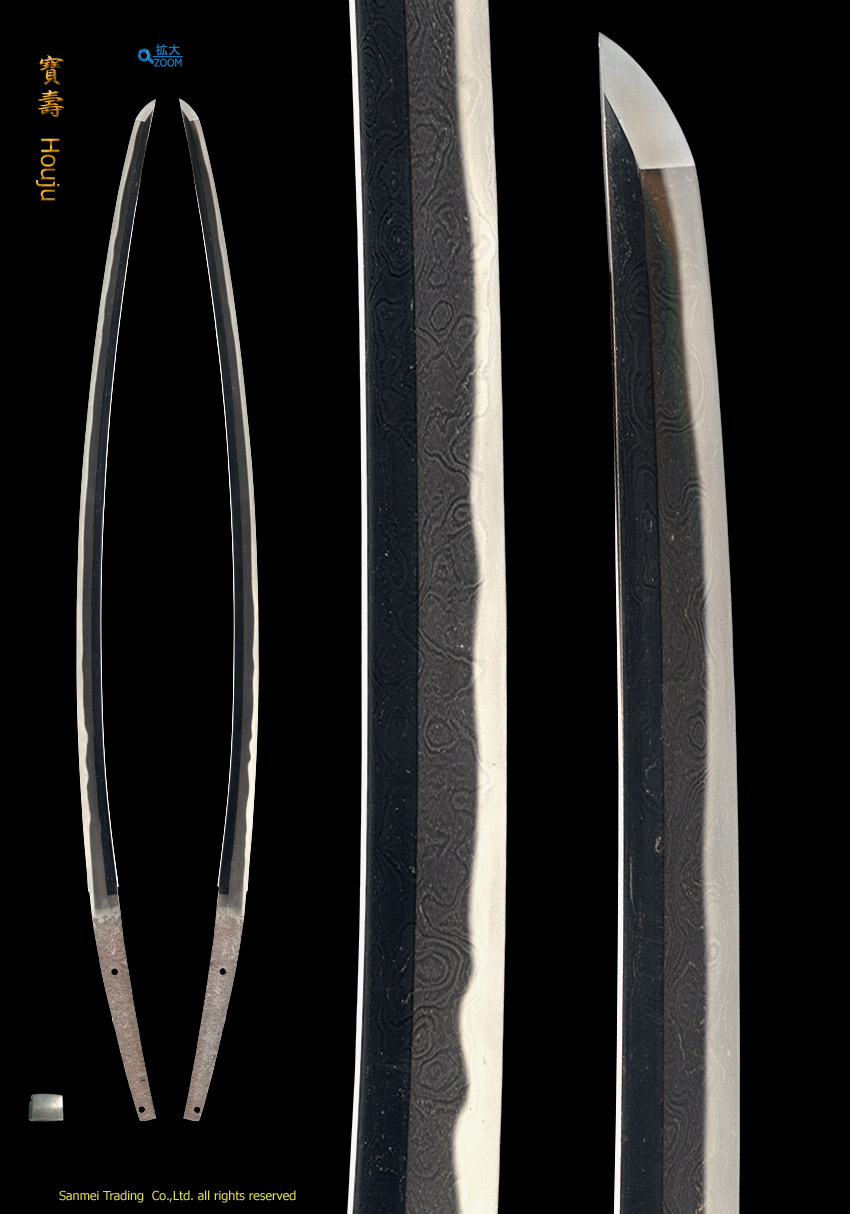Length of cutting edge 82.5cm Curvature 3.4cm Width of base 32.3mm Thickness of base 6.9mm Width of Yokote 16.6mm
Forging(Hada): Forging is large Itame, mixing with Mokume burl and AYASUGI cross grain indication. The entire forging appears conspicuously visible and it's surface is deeply covered in speckled sparkling ji-nie glitter that generates darkish Nie lines grain so called CHIKEI activity. The entire steel is a bit on darkish side and forging scene is full of classical grace.
Temper(Hamon): Hamon is a bit on strong side Nie based, Notare wavy mixing with small and irregular "Gunome" and "Togari-ha". Some Hotsure fray indication appears along quench area. The interior of temper is filled with mist-like crystallize area deeply and shows activity of thick lines of Nie KINSUJI or slight lines of SUNAGASHI. The entire quench scene is a bit dim in the soft and soaked hard metal granules of Nie with deep Nioi area.
Temper of tip(Boshi): Quench of Boshi is frequent Hakikake indication like a flame with sharpened up indication then turns back deeply.
Tang(Nakago): Nakago is UBU original. Two peg holes. Kiri (horizontal) filemarks. Back ridge of Nakago is flat and Kiri (horizontal) heel shape.
Antient times, culture of steel was introduced into Tohoku region, possibly earlier than other routes, from the Eurasian Continent through Mamiya (Tatar) Straights, leading to Hokkaido and Tohoku region.There is also a theory that the etymology " Tatara 踏鞴 " of the iron melting blower originates in " Tatar " exactly .
There is a description of "Country of Hinomoto (northern Kingdom of Emishi) 日本国" and also " Country of Wa (western court of Yamato) 倭国 " in the ancient book of China "Kutouho 旧唐書". In the process of the powerful Yamato Court government ruined kingdom of Emishi 蝦夷 and formed the central unity of Japan, name of "Hinomoto = Japan" was inherited as the official country name.
In the background the ancient Yamato Court attacked vehemently "northern kingdom of Emishi", at the time it was a only production center of gold and also it was famous center of iron sand or " iron rice cake 餅鉄" and the other important resources such as lacquer and traditional paper that were essential to the culture of dynasty and nobility. Also to acquire the advanced iron culture symbolized by the Bracken Chop Sword "Warabite-to 蕨手刀", Yamato Imperial Court seized blacksmith technology and iron resources of Emishi as this is considered the designation " Fushu
After the most of swordsmiths in Northen Japan had suffered a crushing blow by the fall of Oushu Fujiwara clan 奧州藤原氏 in Bunji 5 (1189), quite a few lineages such as Houju 寶壽 or Gassan 月山 had been active in generations in the Middle Ages (kamakura-Muromachi) and some of them had moved to Kyushu island to hand down their traditional techniques of AYASUGI cross grain forging.
The subject Tachi, it is hardly legible of inscription due to rust since 14th century, is a typical work of Houju that admirably holds the original figure of End Kamakura period with wide "Funbari" standing firmly and also expresses the highlight of the sublime beauty of forging scene - impressive large Itame, Mokume and Ayasugi (cross grain) marks. Fine steel gives off reflected, mottled sparkling effect of Utsuri of ancient Middle Ages.
An old good polish/Condition scale: excellent-very good (using a scale of mint-excellent-very good-good-fair-poor).
Silver ground Habaki collar, preserved in a Shirasaya plain wood mounting

